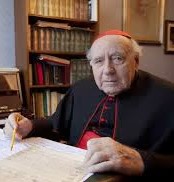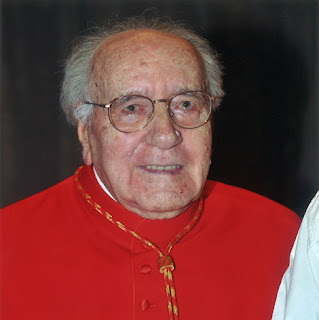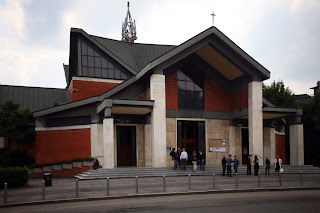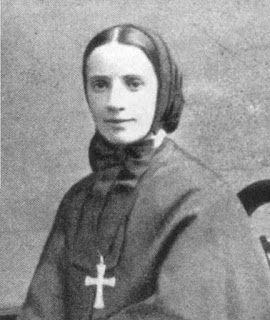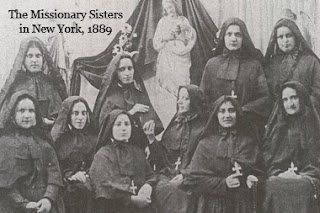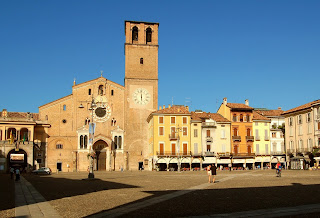Tour de France champion was clandestine courier
 |
Gino Bartali on his way to victory in the
1938 Tour de France |
Gino Bartali, one of three Italian cyclists to have won the
Tour de France twice and a three-times winner of the Giro d’Italia, was born on
this day in 1914 in the town of Ponte a Ema, just outside Florence.
Bartali’s career straddled the Second World War, his two
Tour successes coming in 1938 and 1948, but it is as much for what he did
during the years of conflict that he is remembered today.
With the knowledge of only a few people, Bartali repeatedly
risked his life smuggling false documents around Italy to help Italian Jews
escape being deported to Nazi concentration camps.
He hid the rolled up documents inside the hollow handlebars
and frame of his bicycle and explained his frequent long-distance excursions as
part of the training schedule he needed to maintain in order to keep himself in
peak physical fitness.
In fact, he was carrying documents from secret printing
presses to people who needed them in cities as far apart as Florence, Lucca,
Genoa, Assisi, and the Vatican in Rome.
Sometimes he would pull a cart that contained a secret
compartment in order to smuggle Jewish refugees in person into Switzerland,
explaining that hauling a heavy cart was also essential to his training
routine.
 |
Bartali resumed his career after
the War, winning a second Tour |
He even hid a Jewish family in the cellar of his house in
Florence, in the full knowledge that were they to be discovered he would have
almost certainly been arrested and sentenced to death.
Bartali, who died in 2000 at the age of 85, never spoke publicly about his secret role and
revealed details only gradually to his family in later years.
They concluded that the motivation for his actions lay in
his devout Catholicism and his opposition to the policies being pursued by
Benito Mussolini.
In a speech in September 1938, Pope Pius XI had proclaimed
that anti-semitism was incompatible with Christianity, yet earlier in the year Mussolini
had published his Manifesto on Race, which would lead to Italian Jews been
stripped of citizenship, barred from public office and from working in any
recognised profession.
When Bartali won the 1938 Tour de France, Mussolini hailed
him as a national hero for having provided evidence through his sporting
success that Italians too belonged in the ‘master race’ that Mussolini’s murderous ally
Adolf Hitler aimed to create.
Bartali was horrified. Determined to distance himself from
Mussolini, he refused the invitation to dedicate his triumph to Il Duce.
Mussolini was less than pleased but Bartali’s popularity
with the Italian public, who had cheered him to victory in the Giro in 1936 and
1937, dissuaded him from any punitive action.
Bartali’s standing was also helpful on the occasions he was stopped and
questioned about his long-distance ‘training’ exercises.
 |
Bartali is said to have been born in rooms
above a bar in Ponte a Ema |
He would allow himself to be interrogated but asked Fascist
officials not to dismantle his bike because it was precisely calibrated for
optimum performance and to disturb it would jeopardise his future success.
For the early part of the War, the Catholic Church’s
position on anti-semitism meant that Italy remained a country in which Jews
could take refuge, despite Mussolini’s malign intentions.
It all changed, however, when Italy surrendered to the
Allies in 1943. The German army occupied northern and central parts of the
country, setting up a puppet republic with Mussolini in charge, and immediately
started rounding up Italian Jews and sending them to concentration camps.
It was at this point that Bartali was asked by the Cardinal
of Florence, Archbishop Elia Dalla Costa, to join a secret network offering
protection and safe passage to Jews and other endangered people. His talents were almost tailor-made for him
to become a courier.
The work of this network and other organisations and individuals sympathetic to the plight of minorities meant that around 80 per
cent Italian-born and refugee Jews living in Italy before World War Two
survived.
After the War, Bartali resumed his cycling career and,
remarkably, won his second Tour de France in 1948, matching the achievement of
Ottavio Bottecchia, who won twice in the 1920s, and setting a standard that
Bartali’s rival, Fausto Coppi, would attain when he won in 1949 and 1952.
 |
Bartali's 1948 Tour de France bike on display in the
museum at the church of Madonna del Ghisallo |
Again, it was a victory with political significance. Coinciding with the unrest in Italy in the
summer of 1948, when a power struggle was under way between the United
States-backed centre-right Christian Democrats and the Italian Communists,
Bartali’s victory came at a critical moment for the country, when the attempted
assassination of the Communist leader Palmiro Togliatti threatened to push
Italy into civil war.
It meant that newspaper headlines were suddenly dominated by
the fairytale story of Bartali, who had won the Tour at the age of 24 in 1938
and was winning again at the age of 34.
Commentators believe the distraction changed the mood of the country
just enough for tensions to dissipate.
Bartali, who quit racing at the age of 40 after suffering
injuries in an accident, had been born into a strictly religious family in
Tuscany and his nickname on the circuit was ‘Gino the Pious’.
He was posthumously awarded with the honour Righteous Among
the Nations by Yad Vashem, the Holocaust memorial and education centre in
Jerusalem.
Travel tip:
Bartali’s former home at Via Chiantigiana 177 in Ponte a Ema
is now the home of a museum dedicated to his life and success on two
wheels. All Bartali’s medals and
trophies are on display in the museum. There is also a room with items relating to many
other cyclists and a collection of bicycles from the end of the 19th
century to the middle of the 20th century. The museum is open from Wednesday until
Saturday from 9.30am, remaining open until 7pm on Thursday and Friday.
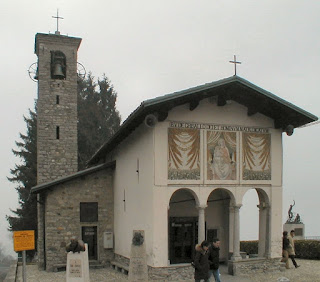 |
| The church of the Madonna del Ghisallo |
Travel tip:
The bike on which Gino Bartali won the 1948 Tour de France
can be seen at a fascinating museum within a church on top of a hill
overlooking Lake Como in Lombardy. The church of the Madonna del Ghisallo is
said to have been commissioned in the 11th century by a local count –
Ghisallo – on the spot where he claimed an apparition of the Virgin Mary saved
him from an attack by bandits. Soon, the Madonna was adopted as the patroness
of local travellers. When, many centuries later, the hill - which offers
spectacular views as well as demanding conditions for those on two wheels - became
part of the Giro di Lombardia cycle race and, on occasions, the Giro d’Italia,
a local priest proposed that the Madonna del Ghisallo be declared the patroness
of cyclists and Pope Pius XII duly obliged. This prompted competitive cyclists to
donate all manner of memorabilia, including bikes and jerseys, building a
collection so large that the church ran out of space to display everything and
an overflow building had to be constructed in the grounds. As well as his bike, outside the church there is a bust of Bartali, alongside busts of Fausto Coppi and the five-times
Giro d’Italia winner Alfredo Binda.
